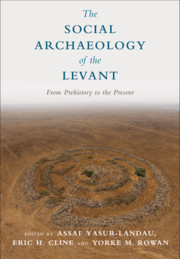Book contents
- The Social Archaeology of the Levant
- The Social Archaeology of the Levant
- Copyright page
- Contents
- Figures
- Tables
- Contributors
- Foreword
- Acknowledgments
- Abbreviations
- Prologue
- Part One
- Part Two
- Part Three
- Fifteen The “Conquest” of the Highlands in the Iron Age I
- Sixteen Iron Age I Philistines
- Seventeen Moving Beyond King Mesha
- Eighteen A Social Archaeology of the Kingdom of Judah
- Nineteen Phases in the History of the Kingdom of Israel
- Twenty The Alphabet Comes of Age
- Part Four
- Part Five
- Part Six
- Epilogue
- Index
- References
Fifteen - The “Conquest” of the Highlands in the Iron Age I
from Part Three
Published online by Cambridge University Press: 14 December 2018
- The Social Archaeology of the Levant
- The Social Archaeology of the Levant
- Copyright page
- Contents
- Figures
- Tables
- Contributors
- Foreword
- Acknowledgments
- Abbreviations
- Prologue
- Part One
- Part Two
- Part Three
- Fifteen The “Conquest” of the Highlands in the Iron Age I
- Sixteen Iron Age I Philistines
- Seventeen Moving Beyond King Mesha
- Eighteen A Social Archaeology of the Kingdom of Judah
- Nineteen Phases in the History of the Kingdom of Israel
- Twenty The Alphabet Comes of Age
- Part Four
- Part Five
- Part Six
- Epilogue
- Index
- References
- Type
- Chapter
- Information
- The Social Archaeology of the LevantFrom Prehistory to the Present, pp. 283 - 309Publisher: Cambridge University PressPrint publication year: 2018
References
- 2
- Cited by

